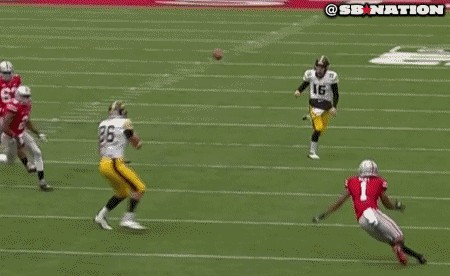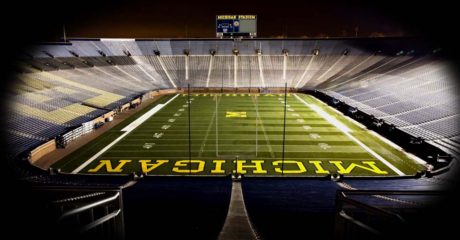
Joe Julius is the answer to the question: What would Jared Lorenzen be like if he grew up in London?
Targeting is a penalty that has gained more and more attention in recent years, as leagues try to prevent head injuries in order to preserve players’ health and the game itself. But a lot of people still have no idea what targeting is. It came up in Michigan’s game against Penn State on Saturday, when PSU linebacker Brandon Smith was booted for targeting wide receiver Grant Perry. It came up again later in the game when some Michigan fans thought kick returner Jourdan Lewis was targeted by PSU kicker Joe “Big Toe” Julius.
Hit the jump for a discussion of the rule and some examples.
THE RULE
Here’s a link to the American Football Coaches Assocation (AFCA) rule on targeting (LINK). Targeting can be called for two reasons:
- The defender or blocker leads with the crown of his helmet when making contact.
- The defender or blocker makes forcible contact to the head/neck area of a defenseless player.
Here is a textbook example of targeting:

Ohio State cornerback Bradley Roby leads with the top (crown) of his helmet, makes an upward and forward thrust with his body, appears to have intentions beyond making a common football play, and hits a defenseless receiver (who just caught the ball and is turning his head to get upfield).
Below is the Brandon Smith play:
Penn State LB Brandon Smith has been ejected for targeting. pic.twitter.com/WYy7jgLNn2
— Evan Petzold (@EvanPetzold) September 24, 2016
As you can see, Grant Perry fits the role of a defenseless receiver. Smith makes forcible contact to the head/neck area with his shoulder pad. What’s not clear is his intent. Was he clearly trying to hit Perry in the head? I don’t think so. But here’s a significant part of the rule:
When in question, it is a foul.
Smith might have been going for the ball only, but it’s also possible that he was making a play on the ball while also punishing the defenseless receiver with an illegal hit. That’s where my comment about “intent” came from in Sunday’s post-game thread. Referees can’t be responsible for knowing what’s going through a player’s head.
Lastly, here’s the play where 5’10”, 271 lb. Penn State kicker Joe “Big Toe” Julius levels Jourdan Lewis.
/cdn0.vox-cdn.com/uploads/chorus_asset/file/7160239/joeyhit.0.gif)
First and foremost, Jourdan Lewis was not a defenseless player at this point. He had already run several yards with the football. The vast majority of targeting calls happen because of a defenseless player, but that’s removed from the equation here. Furthermore, contact from Julius’s shoulder and arm come across the chest and shoulder of Lewis, so it’s not a clothesline tackle or forcible contact to the head/neck area in that respect. The only option remaining to enforce this as a targeting call is to see if Julius leads with the crown of his helmet. In this case, he hits with the side of the helmet, removing any chance of him fairly being called for targeting. Once a runner, or player in general, is no longer “defenseless,” it’s very difficult to find targeting unless it’s a blatant spear by the offending player.
You need to login in order to vote


I think the problem is the incredible inconsistency used by both the on field refs and booth reviews. On the field, the PSU play makes sense. But the booth should have seen the lack of intent and overturned it. Meanwhile, there was a horrible play in the Stanford vs UCLA game that nearly decided the outcome and for some unknown reason the field and booth refs didn’t call it. Not to mention the plays from last year against MSU or MN. All we want as fans, coaches, or players is consistency.
You need to login in order to vote
I don’t think the replay necessarily eliminated intent as a factor. “When in question, it is a foul.”
Also, the call in the Stanford vs. UCLA game was probably the correct one. I think people are really having a tough time understanding that you have to be a DEFENSELESS PLAYER to be targeted, except if the “offending player” hits with the crown of his helmet. Owusu was not a defenseless player. He was running with the ball.
The only remaining argument for targeting is if the defender used the crown of his helmet to initiate contact, and I don’t think he did. Here’s a link to a couple clips:
http://sports.yahoo.com/news/refs-inexplicably-miss-targeting-penalty-on-brutal-ucla-hit-020755446.html
You need to login in order to vote